If you read our piece on the Intel Xeon E-2100 launch SKUs and Value Analysis you will note that we see this as a major evolution from the previous year’s SKU launches. Since the Intel Xeon E3 branding is being replaced by the new Intel Xeon E-2100 (E is for Entry-Level in this case.) We decided to take an opportunity to look back at the Intel Xeon E3-1200 series history and see how each generation was launched.
Background: Previous Generation Intel Xeon E3-1200 Launch SKUs
We are going to look at the major launches and in most cases not cover the later mobile Xeon E3 launches nor most of the refreshes. Intel tends to add SKUs over time, but we wanted to focus on the major launch cycles.
In the Beginning: Intel Xeon E3-1200
The Intel Xeon E3-1200 is now often referred to with a “V1” but it is the first Intel Xeon E3 series before the “V” nomenclature was commonplace. This was based on the Sandy Bridge core and featured 2-4 cores and 20-95W TDP. Of the 11 launch SKUs, five had integrated graphics. We pulled this from our Intel Xeon E3-1230 Sandy Bridge Benchmarks and Review.

This was a huge upgrade over the previous Xeon X3400 (Lynnfield) series CPUs as it moved to the Sandy Bridge architecture. One was still limited to 16GB of DDR3 (UDIMM) or 32GB of DDR3 RAM (RDIMM), but it was a big deal at the time. Sandy Bridge Xeon E3-1200 parts could use less expensive DDR3 UDIMMs to hit 32GB. They also introduced the iGPU in this class of servers for the first time. If you look at what was happening on the consumer side, this is about when Intel started its iGPU campaign. Intel took the consumer CPU die, enabled ECC memory support and changed a few features to create the Xeon part.

One must remember that AMD Opteron was still a major server player at this point, virtualization saturation was lower, and Sandy Bridge helped Intel cement the market from competitors.
Intel Xeon E3-1200 V2 Ushers in Ivy Bridge
In 2012 the Intel Xeon E3-1200 V2 line based on Ivy Bridge came out. This was notable because it was the first generation 22nm product in this segment. It was also the first introduction to PCIe Gen3 in this line as the first generation E3’s still used PCIe Gen2.
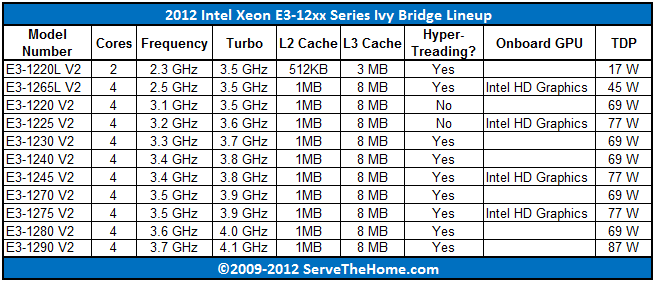
Here we saw four of the eleven SKUs launch with Intel HD graphics. Going back in STH history, yes we had an Intel Xeon E3-1230 V2 Ivy Bridge Xeon Review 4C/8T 3.3GHz.
The transition to PCIe 3.0 was important in servers because it was the transition that allowed significantly faster RAID controllers, NICs and other devices. When you are in the low end of the market like with the Xeon E3 line, you have limited PCIe lanes so effectively doubling the performance of a lane goes a long way. Six years later, the new Intel Xeon E-2100 is still using PCIe Gen3 which is constraining modern servers.
The Pinnacle: Intel Xeon E3-1200 V3 Haswell
Haswell came around in 2013 and our Intel Xeon E3-1200 V3 Series Compute Value Comparison broke down the SKU stack again. One of the big features was moving a lot of the voltage regulation onto the die which means that TDP pre and post-Haswell are not a direct comparison. We discussed this change in our reviews of the day. You can see, this is about when we started doing value analysis at STH:
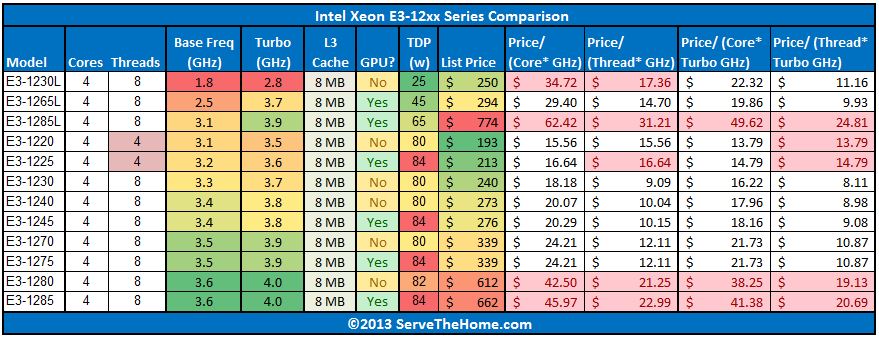
With Haswell, there were three low power SKUs, two with GPUs. In total there were twelve launch SKUs, half of which had integrated GPUs. Haswell was not done, however.
The V3 generation broke a huge portion of the market for AMD. In late 2012 we covered AMD Opteron 4300 and Opteron 3300 Series Server CPUs Launched. STH was the only site to benchmark and review the AMD Opteron 3300 series. AMD Opteron 3380 Review. By the time we were doing that review, AMD was telling us that they were “not intended to compete with Intel on a performance basis” and “only for value-conscious European dedicated hosting customers.”
This week we published our AMD EPYC 7551P Benchmarks and Review A 32 Core Value Monster piece. My how the tables have turned!
The Missing Generation: Intel Xeon E3-1200 V4
The Intel Xeon E3-1200 V4 series was delayed to the point that Intel essentially skipped the generation for mainstream servers and workstations. Instead, in 2014 we got a refresh of the Xeon E3-1200 V3 series. You can read about that here 2014 Refresh: Intel Xeon E3-1200 V3 Value Comparison.
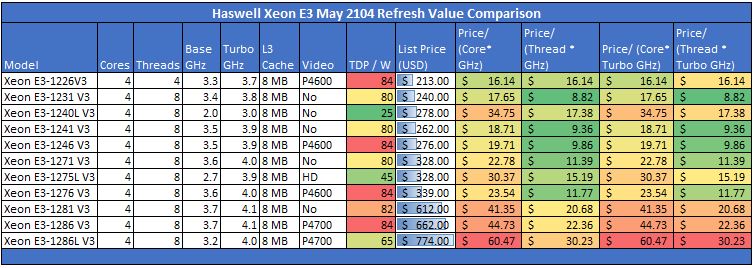
There were 11 refresh SKUs. Again there are three low power SKUs and six SKUs with iGPUs. Clock speeds were mostly up a nominal amount. This is all Intel had to do with no competition. Intel had such a stranglehold on the market with Avoton and Rangeley at the low end (killing off the AMD Opteron A1100) and the Xeon E3-1200 V3 line that this nominal speed bump was all it needed. Broadwell was never a mainstream “Intel Xeon E3-1200 V4.” Even in 2014 when this was all Intel needed to do, we posited that Intel can hold ARM (largely) out of the data center for 3 years. It took 4 years and now the Cavium ThunderX2 is a Real Arm Server Option.
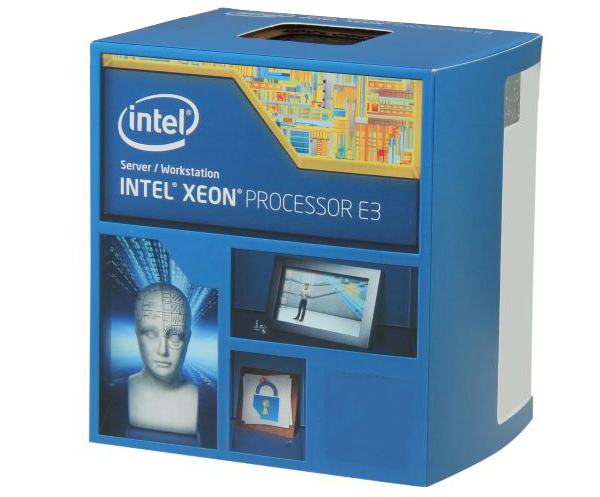
The Intel Xeon E3-1200 V3 refresh essentially made the 22nm generation last from Q2 2012 to Q4 2015. Just looking at the V3 generation that was Q2 2013 to Q4 2015. There are very few segments and competitive situations where a 100MHz speed bump can satisfy a market for two and a half years.
The other major happening during the V3’s reign was Xeon D. The Intel Xeon D-1500 series launched in Q1 2015 and set off now two series of CPUs. Here is the summary of that in Exploring Intel Xeon D Evolution from Xeon D-1500 to Xeon D-2100
The next big change happened in late 2015 and it was a big one. We are going to cover that on the next page along with the new Xeon E-2100.

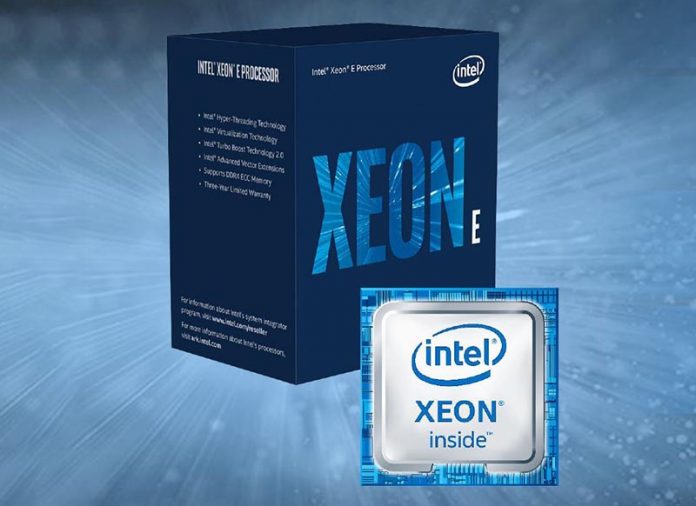



If Xeon E is not meant for server anymore, it should have a name other than Xeon.
Being a high-end workstation processor, it lacks PCIe lanes, lacks ram capacity and severely lacks in its iGPU capabilities. For cache we still get 2MB per core as always.
I really do not see how this new E line is a major change from what we have been offered the past 5-6 years.
Patrick, you mention: “There were also 4.0GHz turbo clocks for the first time. ” — for Haswell, but in the table above for Ivy Bridge you list at least two CPUs with >= 4.0 GHz. So either of those two is buggy.
Marcelo B: Xeon E is limited in several ways, but on the other hand as a software engineer I can see its usage for simple edit/compile/link workflow. It’s top-class 4.7GHz perf is hopefully something which is unique. Can I have 4.7GHz in Xeon W line? No, this ends on 4.5GHz. Also look at pricing and cache sizes! Xeon-W is completely non-competitive with Xeon E (if yo do not require more than 64GB RAM and more PCIe lines). Can I have 4.7GHz in Xeon SP line? Bronze/Silver out of question completely, only gold remains with 6144/6146 but reaching only 4.2GHz! Also look at the pricing!
So Xeon E certainly do have its own value for some specific target audience. Do not get me wrong, I would fight for Ryzen, but since Ryzen is not in major OEM workstations nor board provided by trustful maker which knows how to make ECC support (Supermicro/Tyan), then I’m again in Xeon E domain. Yes, the big temptation is for example asrock with their taichi board (for ryzen) but those silly rgb leds and gaming nature usually throw me off. I’d like to have engineering board like x11sca-f or similar, in fact I would much prefer if such board would have 2-3 DPs instead of DVI/HDMI, but well, man can’t have everything right?
Xeon E-2100 has RAS, like xeon W ?
Frede: no, Xeon E does not provide any RAS feature except perhaps simple ECC, concretely SECDED (single error corrected, double error detected).
“Minecraft server”
And that pretty much sums up the possible use cases for these new ‘xeons’. I’m guessing they would make decent smb servers for those running maybe 2 (single Win Serv license) VMs and Windows Storage Spaces for an AiO server… But you’re still going to run into the same issues the E3s have: no room to breath, now or later.
Micah: IMHO Xeon E is not well suited for *general* server deployment. Even Intel knows that hence stressing its workstation usage again. For server you need Xeon D or SP, or well even better AMD EPYC of course. :-) On the other hand you can still find some server niche where you need highest single-thread perf. available and yet your problem is smaller than 64GB RAM, then Xeon E is probably best choice. But that would be really some niche…
“… then Xeon E is probably best choice. But that would be really some niche…”.
That niche is called, “Home”.
I still have some homelab Sandy Bridge E3-12x0s and they all run 32GB ECC in UDIMMs, 4x8GB. Great read!
I have a Dell R710 in a small office – 4 users – on windows sbs2011.
They run some accounting and payroll software (on mssql) which is badly coded and needs super fast single core performance.
Xeon E will be a perfect fit there but the only ready product is dell precision 3930 and they are selling it only with Windows 10.
In fact, I don’t know if windows server 2016 will work without problems.
Does anyone know if a server with Xeon E is prepared for launch?